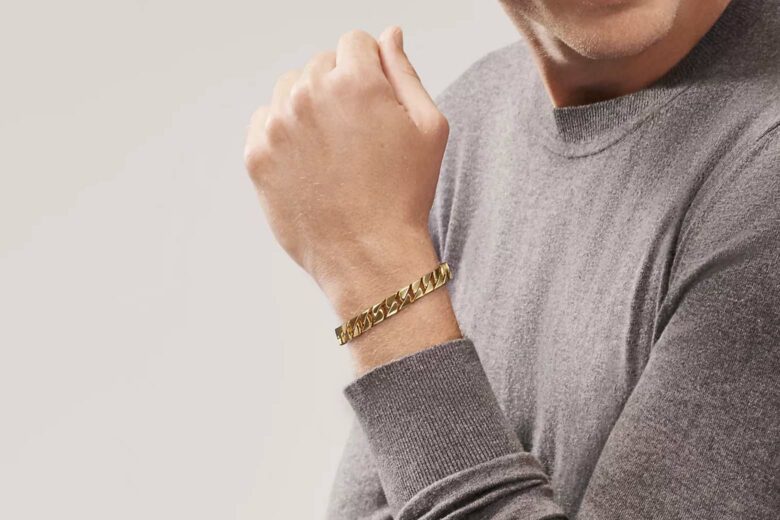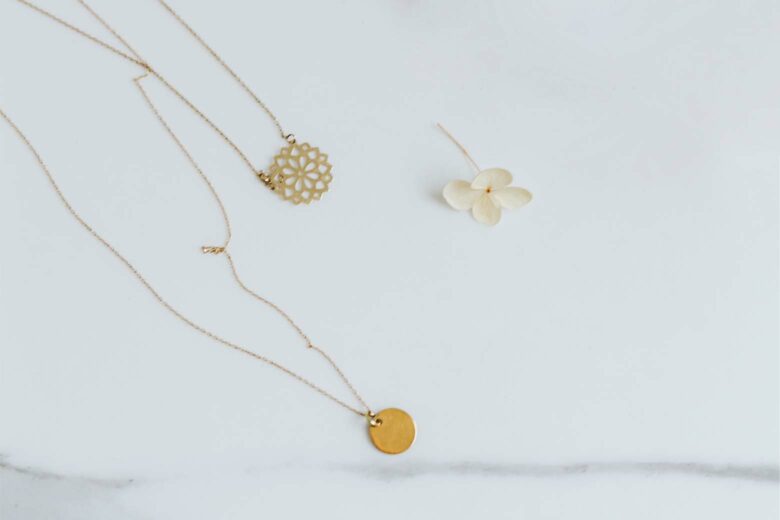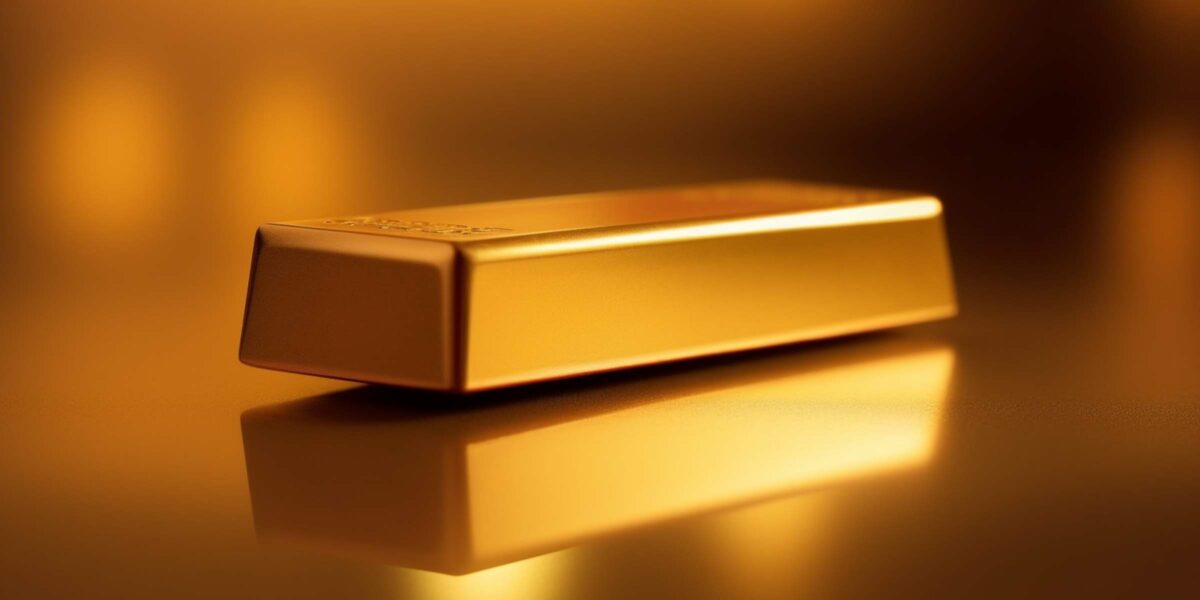From adorning the heads of queens to collaring the necks of pharaohs, gold jewelry has always been a symbol of wealth, power, and divinity. And while all types of gold hold their place in history, there is no version more classical and pure than yellow gold.
Yellow gold is what we think of when we imagine embellished royal crowns, the most expensive engagement rings in history, and Ancient Egyptian collars. And it’s what comes to mind when conjuring up thoughts of pirates’ treasure coves and Rumpelstiltskin’s magic powers.
But yellow gold isn’t just adored for its noble associations, ethereal allure or divine connotations, it’s also considered to be one of the most fashionable precious metals.
Yes, overly ornamented yellow gold pieces were once considered too excessive for everyday wear. But today, our best jewelry brands are using the precious metal to design more contemporary, geometric jewelry pieces that belong in our favorite jewelry organizers amongst the other all-time greats.
Looking for your new favorite earrings? The elegance of yellow gold warped into avant garde designs hits the elusive sweet spot between timeless and trendy in a way that no other precious metal can. In search of everyday necklaces? Neatly stacked and perfectly matched, you can’t go wrong with the inherent permanence of yellow gold chains and warm pendants. Prefer to wear your heart on your sleeve with beautiful bracelets? You’ll never regret the Midas touch.
And with that, let’s dig (mine?) deeper into what makes the precious metal worth its weight in gold—literally.

What is yellow gold
There are many different types of gold—from white to rose to yellow. And whilst each has its place, there is none quite as classical and traditional as yellow gold.
As the only type of gold found naturally, yellow gold is what we refer to when we describe something as “golden.” It’s also the most similar aesthetically to pure gold and is the base color of every type of gold before its hue is altered by other metals.
Check our dedicated guide to gold colors, comparing yellow gold to white and rose gold, to learn more.
The history of yellow gold
Predating recorded history, the exact time when gold was first mined is unknown. However, archaeological evidence suggests that gold mining may have started as early as 7000 BCE in the areas that are now Egypt and Mesopotamia.
Because gold is yellow in its purest form, yellow gold was the only type of gold used for centuries. And it wasn’t until the early 19th century that goldsmiths began to alter the hue of gold using white and pink metals.
Highly valued by ancient civilizations for its beauty and rarity, yellow gold was used to create elaborate jewelry and decorative objects. It was also believed to hold power as the Egyptians believed that gold was the flesh of the gods, and they used it to adorn their temples and tombs. Yellow gold was similarly used to embellish statues and other works of art in Ancient Greece and Rome. And it very quickly became a symbol of wealth and luxury in various parts of the world.
In the 19th century, gold was discovered in California and other parts of the American West, leading to a gold rush and a surge in the popularity of gold jewelry. In the early 20th century, white gold, platinum, and rose gold were discovered. And although yellow gold is no longer the only precious metal used in jewelry and decor, real gold jewelry remains one of the most classical and timeless choices millennia later.
What are the different types of yellow gold?
Although gold in its purest form is yellow, most solid gold jewelry is actually karat gold. Karat gold is a combination of pure gold and other metals. This ratio impacts various characteristics of the precious metals, including its appearance, durability and value.
The ratio of pure gold to other metals is measured in karats. 24K gold is pure gold, meaning that the metal is 24/24 parts gold. Because 24K gold contains no other metals, it is the richest and brightest form of yellow gold. It is also the most valuable. However, pure gold jewelry is usually considered too soft for everyday wear, and it is usually mixed with other strengthening metals to create a yellow gold alloy. The most popular types of yellow gold alloys are 18K yellow gold, 14K yellow gold, and 9K yellow gold.
18K gold is 18 parts pure gold and only 6 parts other metals. Made up of 75% gold, it is considered the most valuable type of gold commonly used for jewelry. And it is also usually the brightest form of yellow gold found in jewelry stores. When it comes to durability, the precious metal only contains 25% strengthening metals. So although it is more durable than pure gold, it is still prone to scratching and denting.
14K is 14 parts pure gold and 10 parts other metals. This means that it is a lot more durable than 18K gold, but not quite as valuable or bright. Because 14K gold only contains 58.3% pure gold, its resale value is lower and its yellow coloring is more pale and muted. In the same way, 9K gold is only 37.5% pure gold, meaning that it is more yellowish-white in color. This is the least valuable type of real gold, as anything with a karatage of less than 9K cannot be labeled “real gold.”
Is yellow gold real gold?
Yes, yellow gold is real gold. In fact, gold in its purest form is yellow, so you could say that yellow gold is the closest thing to pure gold. However, the term “pure gold” shouldn’t be confused with “real gold.” Pure gold refers to 24K karat gold that contains no other metals. While real gold refers to a gold alloy with a karatage of 9 or more.
Naturally, pure gold jewelry is considered real gold jewelry, but so is all solid gold jewelry that contains a certain amount of pure gold. The same is true for all types of gold, be it white gold, rose gold or yellow gold. Because pure gold is considered too soft for everyday jewelry, almost all solid gold jewelry is made from karat gold that is still considered to be real gold. And even though yellow gold looks most similar to pure gold, this doesn’t make it any more real than other gold alloys of equal karatage.

How yellow gold is made
Yellow gold is made by alloying pure gold with other metals such as copper and silver. Unlike white gold and rose gold, the aim of these metals is not to alter the color of the metal, but simply to strengthen it (and make it more affordable.) This, however, is almost impossible, and the addition of other metals will impact the richness and brightness of the yellow hue.
Although the exact composition of metals in yellow gold alloys varies, the process used to create karat gold is usually the same.
The first step is to melt pure gold in a crucible at a high temperature. Once the gold is melted, other metals such as copper and silver are added to the mixture. The mixture is then stirred to ensure that the metals are evenly distributed. Once the alloy is thoroughly mixed, it is poured into a mold and allowed to cool. Once the alloy has cooled, it is rolled and shaped into the desired form, such as a sheet or wire.
Depending on the intended use, the yellow gold may undergo further processing such as cutting, polishing, or setting stones to create finished jewelry or other decorative objects.
Yellow color and meaning
Named after the precious metal, the color gold refers to yellow gold hue found in nature. Think of golden sunsets, golden wheat or golden honey. The color is a warm, rich yellow, reminiscent of luxury and beauty. And because of this, the color gold typically has positive connotations. Regal and triumphant, it is associated with wealth and prosperity. And just as the precious metal was at the core of Ancient mythology, the color itself has various meanings in today’s context.
The most obvious use of the color gold is in gold jewelry and other fashion accessories. Not only is gold unapologetically fashionable, but it’s also one of the most versatile hues. Consider a sparkly gold purse set against a toned down LBD. Or consider pairing it with a bold red or purple dress—basically, the gold color works with everything. The same can be said of gold jewelry. Although in this case, the color can take on a more sentimental meaning. Often associated with wisdom and enlightenment, gold is a popular choice for charm bracelets and birthstone necklaces. And as one of the most timeless hues, it’s a failsafe choice for lifelong investments such as engagement rings.
Gold is also a popular choice when it comes to home decor. Like yellow, gold is considered warm and inviting, but its metallic shine also gives off an air of opulence and elegance. This uncanny combination sets it apart from all other hues.
And while it works well with almost any color, it works best with complementary hues found in nature such as blues and greens. Just think of a gold lampstand against a rich blue accent wall. Or imagine gold handles set against lime green kitchen draws—the look is as equally fun as it is elegant.

What types of jewelry can be made with yellow gold?
As one of the most sought after precious metals, yellow gold can be used to create a variety of quality gold jewelry. Here are some of our favorite use cases:
- Engagement rings: Yellow gold is great for setting diamonds as it really makes the clear white stone stand out even more. It is also great for masking the slight yellow tint in I or J (see our guide to the 4Cs of diamonds) colored diamonds.
- Wedding bands: As one of the most timeless precious metals, yellow gold is also a popular choice for wedding bands. Our tip: make them match.
- Necklaces and pendants: Yellow gold can be used to create a wide variety of necklaces and pendants, from simple chains to more ornate designs with gemstones. The yellow color pairs particularly well with warmer stones such as pink sapphires, rubies and tourmalines.
- Bracelets: When it comes to minimalist designs, yellow gold is a win. The radiant hue is enough to make a simple accessory scintillate without looking over the top.
- Earrings: We love bold yellow gold earrings featuring geometric designs and asymmetrical shapes. It’s the perfect balance between timeless and trendy.
The options are endless when it comes to yellow gold jewelry. Use the bright hue to hide the flaws in diamonds. Allow it to complement your warmer colored gems. Or contrast the classicism of the precious metal with avant garde asymmetry. Either way, there’s lots to play around with when it comes to this precious metal.
Is yellow gold more expensive than white gold?
No, yellow gold isn’t more expensive than white gold. Both yellow gold and white gold are made from a combination of pure gold and other metals. The pure gold used in both alloys is exactly the same. The only difference between the composition of the two is what other metals are mixed with the pure gold.
The amount of pure gold in the metal is what determines the metal’s value. And because an 18K yellow gold ring will contain the same amount of gold as a 18K white gold ring, they should be equally valuable.
White gold, however, often contains a thin layer of rhodium for extra scintillation and protection. The process used to coat the metal is more costly and time consuming, which can make white gold slightly more expensive than yellow gold.
Does yellow gold tarnish or fade?
Pure yellow gold will never tarnish or fade. However, most solid gold jewelry is not made from pure gold, it is made from karat gold; a combination of pure gold and other metals. The addition of these other metals can make yellow gold slightly more susceptible to tarnishing. Although in general, yellow gold is considered to be one of the most low maintenance precious metals.
Tarnishing is caused by a chemical reaction between certain metals and elements in the air. Most of the metals added to pure gold can cause tarnishing. And therefore, the higher the percentage of “other metals” in a yellow gold alloy, the more likely it is to tarnish. 18K yellow gold only contains 25% other metals and is highly unlikely to tarnish, while 9K yellow gold contains 62.5% other metals and will tarnish quicker as a result.
Check also our guides on the different types of yellow gold to learn more about what to expect when shopping for gold jewelry:
Frequently asked questions about yellow gold
Gold in its purest form is a bright yellow gold. However, most solid gold jewelry is not made from pure gold. It is made from karat gold; a combination of pure gold and other metals. And whilst, karat gold isn’t 100% pure gold, any yellow gold jewelry that is 9 karats or more is still considered to be real gold.
Yes, most yellow gold used to create high end jewelry is good quality. All gold is yellow in its purest form. However, pure gold is considered too soft for everyday wear and most quality gold jewelry is made from gold alloys. Gold alloys mix pure gold with other strengthening metals to make them more durable and long lasting.
Yellow gold is exactly that—yellow. While all gold is yellow in its purest form, yellow gold typically refers to a gold alloy that retains its yellow hue after being mixed with other metals. The hue in different types of yellow gold varies depending on the composition of metals. 18K yellow contains more pure gold than 14K yellow gold, so it will have a richer, brighter hue.
Pure yellow gold does not fade over time. However, the other metals in yellow gold alloys can be affected by wear, scratching, or exposure to chemicals or environmental factors, which can affect their appearance and shine. Therefore, the higher the karatage of solid gold jewelry, the less likely it is to fade or tarnish.










